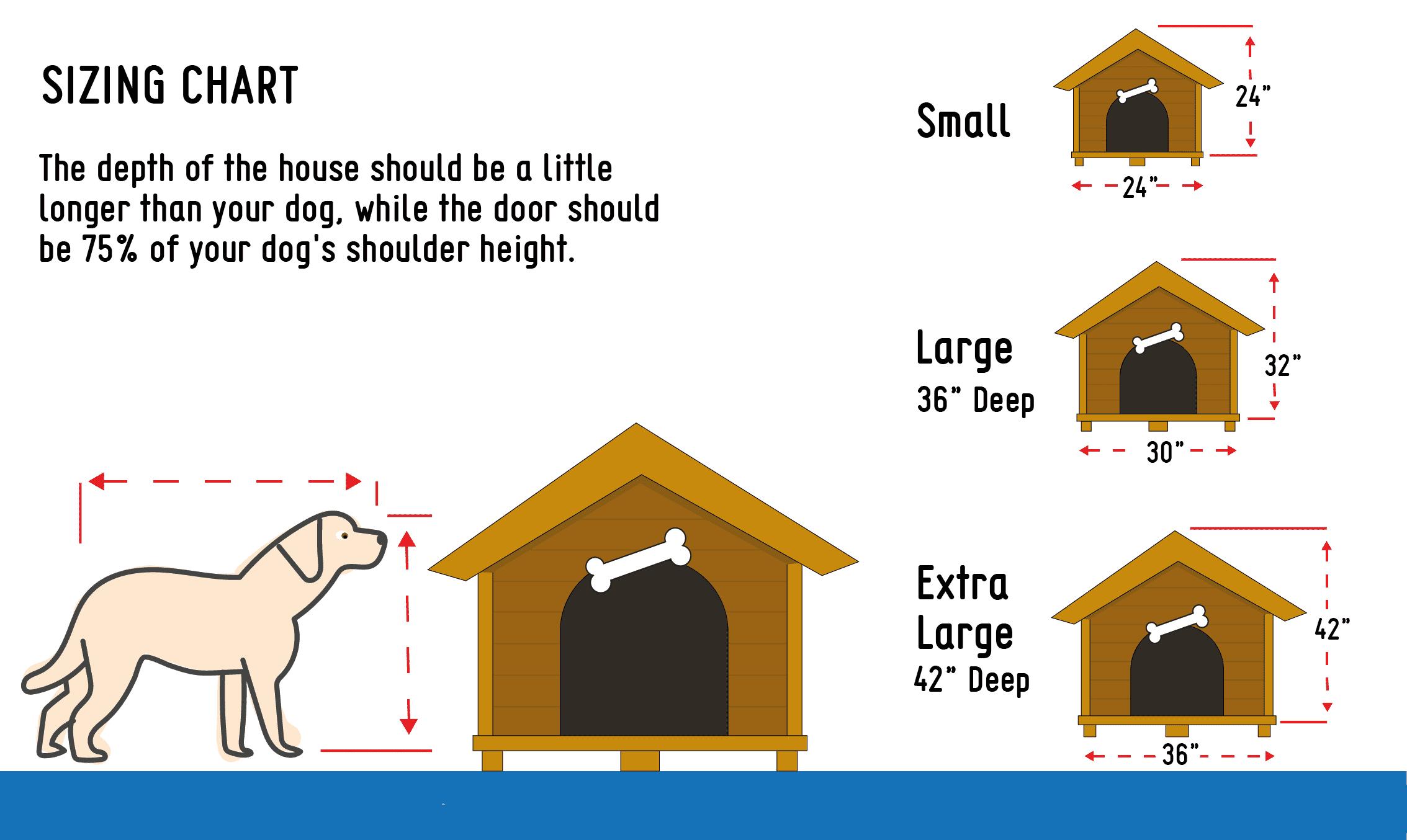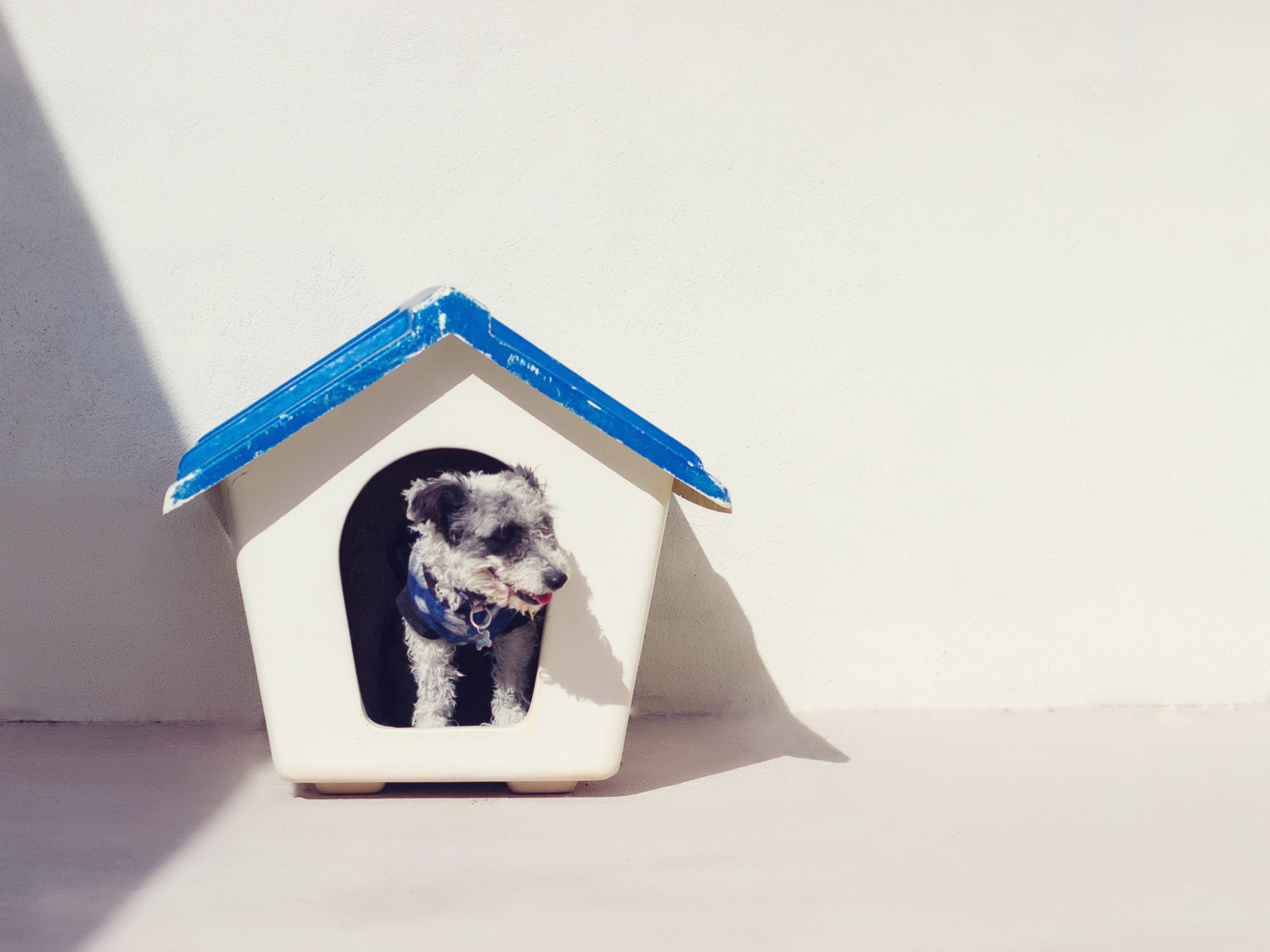7 Dog House Plan Dimension Guides
There’s no one-size-fits-all formula for determining the size of your dog house. You can find a variety of ideas online, some of which we’ve reproduced below:
Finding the Right Dog House Dimensions
At some point, you need to translate the golden rule we listed above into actual numbers so that you can buy (or build) a dog house that fits your pup.
The first step, of course, is to measure your dog. You need to know his length from the tip of his nose to his butt, and his height from paw to shoulder. This way, you can make sure his home fits him perfectly.
Next, you need to decide what kind of house you want to make. Most have slanted roofs, which allows rain to run off and gives your pup more room when he enters the house. This means you’ll need to know how tall the roof is in two places — at the highest and lowest points.
Once you know how big your dog is and what you want your house to look like, it’s easy to figure things out from there — and since the house will be custom-fit for your pup, you won’t have to worry about any variation between the dog house dimensions by breed.

You should absolutely take your local weather into consideration before deciding on dog house dimensions. If you live in an area where it gets incredibly cold in the winter, you might want to make the house a little more snug so that your dog’s body heat is better-preserved.
Likewise, if you live in a place with stifling summers, allowing your pooch a little more room will enable the air to circulate better and keep him cool.

How to Choose the Right Size of a Dog House
There are many different dog house sizing guides to choose from with their own methods and explanations. Here we have gathered some of the most recognized.

Ashville NC Humane Society is an adoption center dedicated to the care of dogs, cats, and small pets. they created a dog house sizing formula specific for a medium dog house with the requirements of an offset entrance and slanted single-panel roof. The formula is:
Pros – This formula is very easy to do. Most people have a tape measure at home and a calculator or access to one on a phone. These are the only tools you’ll need for this. This makes it a relatively cheap checking method as well. All you have to do is measure the height and length of your dog and do a few calculations. You can easily note down the four side measurements in five to ten minutes. This is a brilliant way of calculating the size needed for your dog for this house and dog size.
Cons – Although this method is brilliant for ease and cost, it is too specific. It can only be used for a medium-sized dog for starters which eliminates over two-thirds of dogs and dog owners from participating. Furthermore, if you do not want a dog house with a slanted single-panel roof and an offset entrance, you will not be able to use this formula. It cannot be altered easily either because it would be guesswork on the door size and depth allowance. Furthermore, when relating it to smaller or larger breeds, again, it is not known what the allowance should be because a general number has not been given.
This formula is much more general and can be used to create a basic dog house. It works through the measurement of your dog’s height in inches, and this should be multiplied by the varying amounts below. This will provide you with the required spacing for the door, elevation, width, depth, and height. Cedar Dog House created this spacious guide for dog house sizing.
The A-B-C method:
Which translates, in practical terms, to the below ideal formula:
Pros – This formula is clearly labeled in a step by step plan. It considers all the aspects of the dog’s body and is another cheap and easy method of measuring. All you need is a tape measure to measure the three areas of your dog and a calculator to complete the required sums. This process should take ten minutes to complete so it is not time-consuming. Furthermore, this method provides the minimum requirements according to Cedar Dog House. This can be applied to any dog breed and size easily and quickly. It can also be used to understand the base space requirements for any type of dog house.
Cons – The sizing provided by Cedar Dog House is not the most adaptable as it depicts a standard sizing and shaped dog house. If you were interested in a rounded or corner dog house, the guide can still be used, but it is more difficult to apply. For example, if the distance from your dog’s nose and flank are 15 inches tall, you know the depth and width would have to be 15 inches. 15 x 15 gives you the required floor space of 225 sq inches. As long as this is applied, it may be argued that you could have a circular or corner based dog house. You are able to contact the company for advice on 1-844-339-8180.
A cozier formula is provided by Wood Magazine. It has an easy and simplistic formula that is specially tailored to dogs in colder environments. All you need to do is measure the height and length of your dog and complete a few sums. The formula is as follows.
Pros – This formula is another easy one to follow one with simple and clear instructions. You only require the provisions of a tape measure, your pooch and, you guessed it! A calculator. Three easy sums and you have the dimensions for the dog house appropriate for your dog. Furthermore, these are not difficult dimensions to measure, your dog’s length and height are not intrusive and can be done very quickly. This is the perfect box if you live somewhere cold as it is small, snug and will be less difficult to heat. In larger dog houses, the heat will escape quickly and it may take a long time to warm it up. This dog house sizing guide will give you the cozy dog house that you need.
Cons – Having a smaller dog house comes with quite a few cons. Firstly, your dog may be able to fit inside but are they getting the room they need to stretch? They may also be more likely to be uncomfortable or have trouble getting in and out of the entrance. Furthermore, there is a chance of injury. If your dog is known to get over-excited or can be clumsy, this may not be the most appropriate choice for you. Upon hearing a noise and getting excited too quickly, your dog may bang their head or catch their paws on the entrance, or even slip. Be aware of your dog’s temperament and reactive state before deciding on the appropriate dog house sizing guide.
The final dog house sizing guide on our list is by the Ontario Humane Society and is orientated around giving your dog enough space.
Pros – This dog house is also very roomy, there is no chance when following these recommendations, that your dog will not have enough rooms to stretch and stand. This dog house sizing guide truly has dog ethics and happiness at heart! Moreover, they have considered every possible aspect that could affect your dog, from the hallway to the platform. Each has recommended sizing instructions and example dog breeds, displaying a brand that cares about its consumers.
Cons – Unfortunately, this formula does not work well for practicalities. The large size that is recommended, especially for large breeds, is often not practical. The large size of the dog house may not work in your garden and may take up running space for your dog. It can also be argued whether this amount of space is actually needed. For example, if the height is twice the dog’s height, they may be able to reach on their back legs inside the house. This is not always necessary for just an area to sleep in. Furthermore, The large area of the dog house may not be easy to move if you are renting a property. If you have a large dog, the size of the dog house may not fit in your car or in the property’s garden, this can make moving that much more difficult.
Furthermore, this guide does not have a standard formula. Some areas of the dog house do, but the majority are confusing and you will have to check the website after each new measurement.
What Size Crate Does My Dog Need?
Want to know what size of dog house you need? Look no further! The Dog House Times recommended dog house size chart is here. Featuring doghouse door sizing, ceiling height and floor space.
We researched far and wide, from the Americas to Europe and even New Zealand, to bring you the most precise recommendations on the internet.
There are a few things I want to point out to make sense of this chart. First, the measurements are in imperial. The measurements are recommended for the maximum enjoyment of your dog.